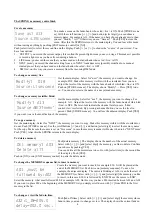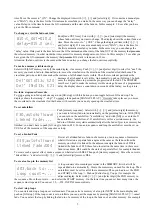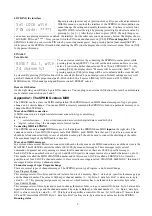
The MIDI-handler of the SPRING knows ‘RUNNING STATUS’. This means: when a status byte is received and
processed, the MIDI-handler remains in that status until a different status byte is received. This means that, during the time
the status is not changed, the midi master have to send only the data bytes of the succeeding messages. Further, the
SPRING recognizes SYSTEM REAL-TIME messages, in that way that RUNNING STATUS remains maintained.
The relation table below is applicable in case of the SPRING.
MIDI message = status byte
+ data byte
--> start fade-in scene
Cn[h]
0
Xxx
Cn[h]
1
Xxx
Cn[h]
2
Xxx
,
,
Xxx
,
,
Xxx
Cn[h]
99
Xxx
'n' is the under 'SET-UP' chosen MIDI channel number. [h] means hexadecimal.
Setting the SPRING for MIDI control
•
Define a channel number for SPRING: set under [SET-UP] “Remote control= MIDI, channelXX”.
Select in the same
menu the desired channel number.
•
Create the memories you need.
•
Repeat pressing [assign] till you get the menu for attaching data byte values with memories.
An example
For example: the SPRING is set on “MIDI channel=4” and “MIDI data= 14 fades in A03”. At the moment the MIDI
master sends the bytes “0C4[h]” and “0E[h]” (E[h]=14 decimal), the SPRING reacts by canceling the going fade and
fading in scene A03.
Layout of the front panel
Beneath you find the front panel of the SPRING. Fader buttons are not visible.
Spring-V3
24/72 digital channel control desk
fade in of the above selected
NEXT scene
Stepped loop mode: push
tempo twice in the desired
step rhythm while pressing
GO/stop for that loop
live
live
live: B33
next: B34
MASTER
fade-IN
sequence
time
assign
control
digit
item
CROSSFADER
fade-OUT
GO
/
stop
memory
EXIT memory
YES
item
up
define
STORE
delete
memory
scene as
loop
sub’s
live
channels
<<
<<
>>
>>
MANUAL PLAY
channel faders or sub-masters
live
live
A
B
1
2
3
4
5
6
7
8
9
10
11
12
13
14
15
16
17
18
19
20
21
22
23
24
1
2
3
4
5
6
7
8
9
10
11
12
13
14
15
16
17
18
19
20
21
22
23
24
1
2
3
4
5
6
7
8
9
10
11
12
13
14
15
16
17
18
19
20
21
22
23
24
NO
MEMORY CONTROL
time
change
set
25
49
26
50
27
51
28
52
29
53
30
54
31
55
32
56
33
57
34
58
35
59
36
60
37
61
38
62
39
63
40
64
41
65
42
66
43
67
44
68
45
69
46
70
47
71
48
72
25
49
26
50
27
51
28
52
29
53
30
54
31
55
32
56
33
57
34
58
35
59
36
60
37
61
38
62
39
63
40
64
41
65
42
66
43
67
44
68
45
69
46
70
47
71
48
72
channel fader 1-24 or 1-72 (spring 24/72)
select
select
3
49-72
2
25-48
1
1-24
LOOP CONTROL
tempo
GO/stop
ENABLE
flash
live or blind
SELECT
control/view
GO/stop
GO
/
stop
3
2
1
LOOP CONTROL
tempo
10




























